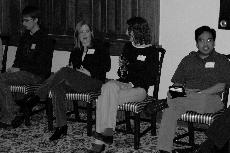Faculty and staff advising groups hear from students

February 13, 2008
For the first time in five years, students were invited to the Faculty and Staff Advising Groups’ discussion in the Matthew Simpson Room last week. By responding to an e-mail sent by Jan Everhart, director of the Lilly Initiative for Vocational Exploration and assistant professor of religion, five students were selected to share how their relationships with advisers, professors and staff on campus are impacting their college education.
Jim Hayes, associate director of the Lilly Initiative for Vocational Exploration, began by discussing the theme and purpose of having students present for the first time.
“What’s been helpful to you?” Hayes said.
Junior Brody Tubaugh told of his student-athlete experience when he transferred to Simpson from Truman State.
“It’s been nice to not worry that your professor doesn’t like athletes and to have them actually care you are playing a sport,” Tubaugh said.
Sophomore Mike Christensen has had three different advisers since freshman year. With each switch, his advisers have assisted him with the changes.
“My experiences have been tremendous for me with everyone sticking their necks out to get what I need done,” Christensen said.
Once students were done sharing, the group of approximately 25 people broke off into five smaller discussions around the room, each consisting of at least three or four adults and one student. Faculty and staff spoke of their encounters with students to find commonalities among their experiences.
Last week’s meeting gave the groups an idea as to how well Simpson’s faculty and staff are assisting students on an academic and personal level.
Most students are unfamiliar with the Faculty and Staff Advising group, which began in July 2003 as part of a $2 million federal endowment granted to the Lilly Initiative. The group consists of eight or nine faculty members and 14 staff employees who serve one year. Both groups meet with their specific section throughout the fall and spring semester and twice together.
The preliminary groups have allowed faculty and staff to explore their own lives through discussion and self-reflection in order to help students answer the big question of understand what to do with their lives. Hayes notes that one goal of the program was to see the advising process through a student’s eyes.
“If one of the reasons why we’re looking at our lives is in order to improve our conversation with students, then probably we should take a look at our conversation with students from their perspectives rather than ours,” Hayes said.
From the faculty perspective, a majority of focus has been directed towards sharing strategies they use when communicating with their students. In concentrating on each other, the goal is for collegial relations to be formed among Simpson’s employees.
“When you know somebody and can pick up the phone, it’s a more collaborative effort,” Everhart said. “I think it’s always easier to work with someone you know.”
As a direct result of the groups’ joint efforts, Simpson has developed structural support to assist advisers. For example, the Faculty Development Office manages a yearlong advising orientation for new faculty, and there is also a faculty advising handbook.
“They’re looking at how to improve the quality of the advising relationship between faculty and student,” Hayes said. “They provide resources.”











